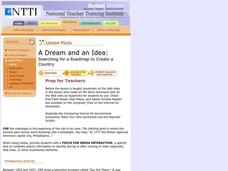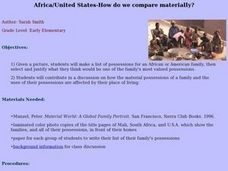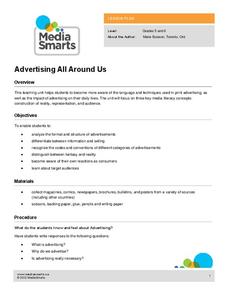Curated OER
What Shape is That?
Each country or group of people has created special places of worship. Children read a story about religious buildings and architecture and then make clay models of the buildings they like the best. The lesson plan has been written to...
Curated OER
Western Hemisphere
Fourth graders use a database to compare countries in the western hemisphere. They describe a variety of regions in Texas and the Western Hemisphere such as political, population, and economic regions that result from patterns of human...
Curated OER
Family Life Around the Globe
First graders examine customs of other nations and compare countries using Venn diagrams. They also write pen pal letters and e-mails to students in other countries.
Curated OER
Comparing Foundations of Democracy
Students examine democratic values. In this democratic ideologies instructional activity, students discuss individual rights and rights of the group. Students also discuss the implications of the priorities made in democratic societies...
Curated OER
Three Wars Equal One New Country: Part 1
Students explore how and why Germany became a nation.
Curated OER
Compare and Contrast Composers
Students identify various pieces of music that are familiar to them and define how the music made them feel. Then they select their favorite piece of music heard and the activities in which they like to do. Students also attend a...
Curated OER
Comparative Geography II
Students engage in a research question of finding the effect of population density upon the use of land in a physical area. They also find the effect of how this can effect the lifestyles of the people who live there.
Curated OER
A Dream and an Idea: Searching for a Roadmap to Create a Country
Students listen in on American historical events. For this colonial America lesson, students participate in an activity that requires them to watch video segments that feature Revolutionary War battles and the Constitutional Convention....
Curated OER
Africa/United States-How do we compare materially?
Students discuss the material possessions of an African or American family. They examine how the material possessions of a family and the uses of their possessions are affected by their place of living.
Peace Corps
Community
What is a community? Find out with a lesson that sheds light onto the different types of communities—school, local, and global. Scholars read informational text detailing the life of a young girl from Cape Verde and take part in a...
Peace Corps
Family
Family traditions are the focus of a instructional activity that explores the lives of children in India and those in your classroom. Scholars examine their own family roles and traditions, then respond to an informative text detailing a...
Museum of Tolerance
Immigration Journeys
Through the journey of four stories of immigration, scholars complete graphic organizers and apply knowledge to create a visual representation of their findings on a large poster. Third and fourth readers write a letter to their family...
Public Schools of North Carolina
Democratic Republic of Congo - Map Skills
Work on your map skills with a packet of activities about the river basins in the Democratic Republic on Congo. Learners study the maps provided before answering the geography questions and writing an acrostic poem about the region.
Media Smarts
Advertising All Around Us
Here is a set of advertising lessons, explore language, techniques, representation, and target audiences. Discuss the impact ads have on our daily lives. What do we see and how do they make us feel? Observe ads from around the world and...
MENSA Education & Research Foundation
Ecosystems
Explore the Earth's different ecosystems through four lessons, an assessment, and extension activities. Lessons include informative text and step-by-step instructions to apply knowledge in interactive, and thought provoking ways; such as...
August House
The Clever Monkey Rides Again
Use a West African folktale to practice several different skills in your first grade classroom. Learners read The Clever Monkey Rides Again and focus on rhyming words, reading comprehension, measurement, art, movement, and word order.
Laboratory for Atmospheric and Space Physics
The Solar Wind Tunnel
The winds of change are blowing in our very own solar system! But what makes some heavenly bodies more affected by solar winds than others? Pupils discover the concept of magnetic forces at work in space in this attractive interactive,...
Curated OER
Who Can Vote? Chart
Students become familiar with historic and contemporary issues connected to voting rights around the world. They research the voting rights history of their country and then compare information about voting rights in at least three...
Curated OER
Homes for Native Nations
Students define native and research natives from their country. In groups, they choose four nations and study the homes in the area, the landscape, and types of buildings. After discussing the meaning of a family, students illustrate...
Global Oneness Project
Far From Home
A timely and provocative lesson inspires high schoolers to tackle the Syrian refugee crisis. They analyze a compelling photo essay before discussing and writing about it.
National Endowment for the Humanities
James Madison: Madison Was There
Madison was there! Scholars go on a journey to discover the person behind the founding father label as they explore James Madison's role in the formation of the United States government. The culmination is a writing assignment and...
Global Oneness Project
Living with Less Water
Did you know that California produces two thirds of the fruits and nuts consumed in the United States? That it produces almost one third of the vegetables? Did you know that scientists warn that California is facing the onset of a...
Curated OER
How Are Boundaries Made, Kept, Broken?
Students perform raps and analyze issues among the rich and poor. They explore how countries are labeled as "third world" and "first world." They create a dialectical journal and examine the country of Nigeria through the reading of...
Curated OER
Different Cultures, Equal Magic
Students compare two fairy tales by filling out the worksheet provided. In this comparing stories lesson plan, students compare the problem, helper, magic objects, and repetition in the fairy tales.

























